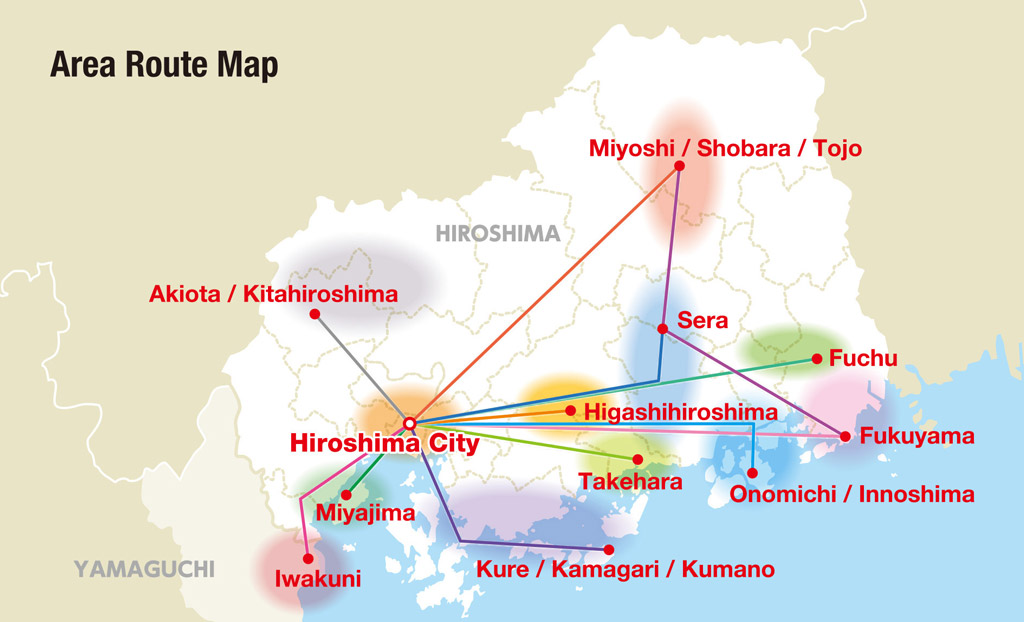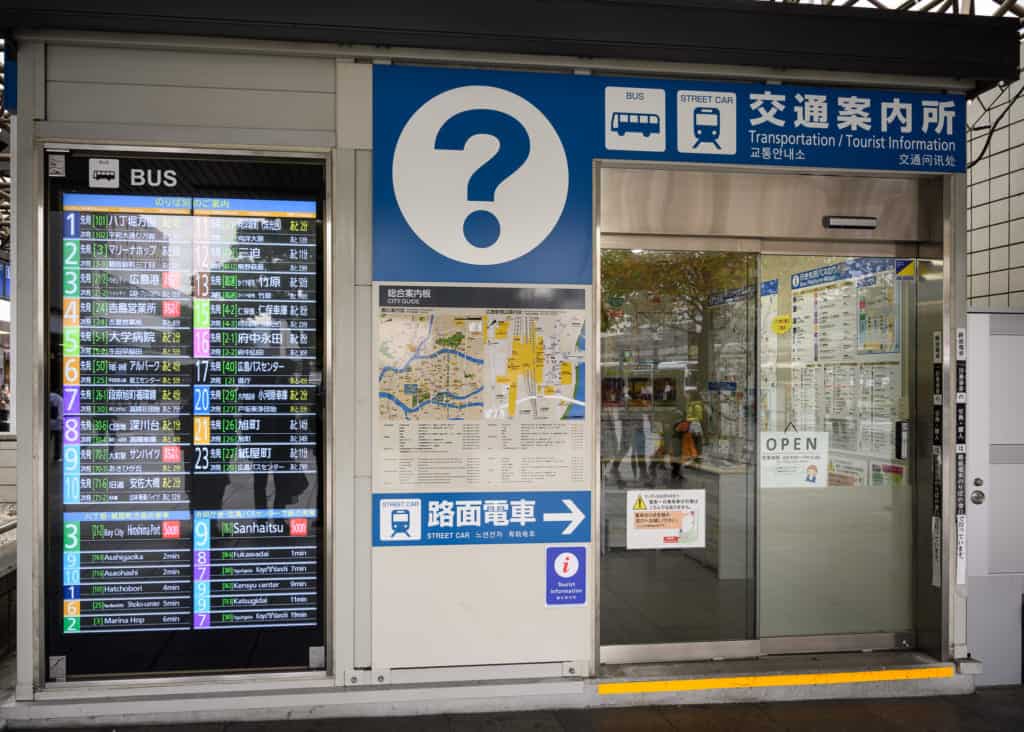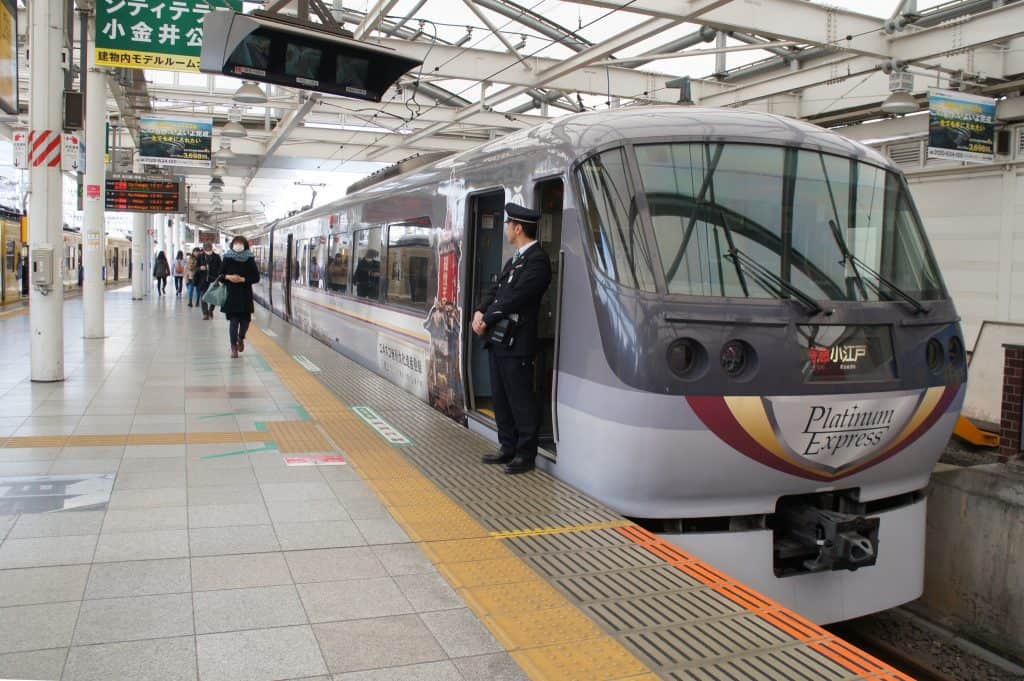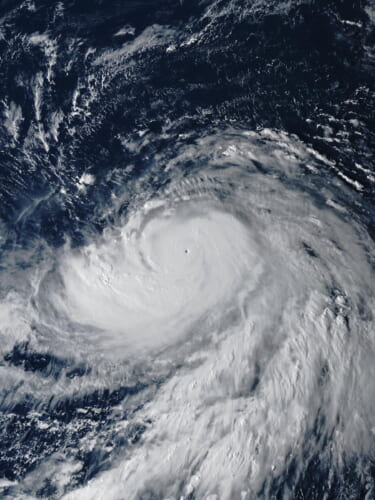With Japan’s famously efficient public transportation systems and its down-to-the-minute punctuality, it’s no wonder why it’s the number one way for many visitors to travel throughout Japan. While the Japan Rail Pass allows foreign visitors to travel across the whole of the Japanese peninsula, a variety of special tourist discount passes are geared towards travellers who desire a richer and deeper sampling a particular region or city.
These special discount passes focus on single cities to a handful of close-knit prefectures and offer unlimited use of select transportation modes within a particular area. From local trains, express trains, monorails, streetcars, cable cars, buses, and boats, these passes eliminate the need to buy multiple fares throughout the day and come in a variety of different validity periods. Some passes also collaborate with local businesses, shops, and popular tourist sites within a region the pass covers, and can be used for discounts at participating locations. Here’s a quick overview of the passes and who they’re good for:
| Regional Pass | What Type of Traveller it’s good for |
|---|---|
| Greater Tokyo Pass Check the Price → | Travellers planning to visit Tokyo and nearby prefectures of Kanagawa, Saitama, and Chiba. They offer unlimited travel for 3 consecutive days. Check here for more details |
| JR Kansai Area Pass and JR Kansai WIDE Area Pass Check the Price → | Travellers focusing on the Kansai region, including the big cities of Osaka, Kyoto, Nara, and Kobe. They come in 1, 2, 3, and 4-day passes with unlimited travel on the local and rapid JR trains and buses within a portion of the Kansai region. |
| Kansai Thru Pass Check the Price → | Travellers staying close to Kyoto and Osaka, with day trips to into Kobe, Nara, Asuka, Koyasan, Himeji and Wakayama. They offer unlimited travel non-JR trains, subways and buses, with 2 and 3 day passes. |
| Hakone Freepass Check the Price → | Travellers visiting Japan’s prime hot spring location, Hakone. The pass offers unlimited access to Odakyu operated buses, trains, cable cars, ropeways, and sightseeing cruises, with 2 and 3-day consecutive passes available. |
| Enoshima-Kamakura Freepass Check the Price → | Travellers in Tokyo looking for the cheapest option to get to ocean town of Enoshima and the Giant Buddha of Kamakura in one day. The pass also includes discounts for various tourist attractions, including aquariums, caves, shrines, art museums, and local restaurants. |
| Visit Hiroshima Tourist Pass Check the Price → | Travellers in Hiroshima, with unlimited travel on all Hiroshima Electric Railway Hiroden streetcars, some local and highways buses, and two ferries to Miyajima island. There are 3 and 4-day passes. |
While there are several different types of special discount passes out there for tourists, here are some of the more popular options:
Greater Tokyo Pass
The Greater Tokyo Pass is a good option if you’re planning to visit both Tokyo and iconic tourist spots in nearby prefectures of Kanagawa (神奈川県), Saitama (埼玉県), and Chiba (千葉県). The pass utilizes a network of private railways and bus lines and offers unlimited travel for 3 consecutive days at a fixed price of 7,200 yen for adults, and 3,600 yen for children (11 and under).
| Greater Tokyo Pass | Cost |
|---|---|
| Adult | 7,200 yen |
| Children (6-11 years) | 3,600 yen |


The pass covers most of the major tourist spots in Tokyo, like the giant red lantern at Sensō-ji (浅草寺) in Asakusa, the temple mountain scenery of Mt. Takao (高尾山, Takao-san); and outwards to the Great Buddha of Kamakura (鎌倉大仏, Kamakura Daibutsu) in Kanagawa Prefecture, or the ornately carved shrine of Nikko Toshogu Shrine in Tochigi Prefecture (栃木県)*. (Tochigi Prefecture is not one of the three prefectures included in the pass, though the lines covered under the Greater Tokyo Pass do extend into the fourth prefecture.)
If you’re planning on keeping your travels within the confines of Tokyo, it would be advisable to get a rechargeable IC card such as PASMO or Suica instead, as travels within the city would likely not reach the Greater Tokyo Pass’s average daily cost of 2,400 yen (for an adult).
The Greater Tokyo Pass Coverage
The 13 private railways covered by the Greater Tokyo Pass include the Tokyo Metro Lines, the Toei Subway Lines, Odakyu Line, Tobu Line, Keikyū Line, Keiō Line, Seibu Line, Sotetsu Line, Keisei Line, Tōkyū Line, Yokohama Municipal Subways, Minato-Mirai Line and Yurikamome Line. A map of the railway and bus lines can be found on the Greater Tokyo Pass website.

JR lines are not covered under this pass. If you’re planning on catching one of the limited express trains, you’ll be required to pay an additional ticket surcharge for seat reservations.
Where to Buy the Greater Tokyo Pass
Passes can be purchased at many of the tourist information centres and offices located within major train stations throughout Tokyo, at ticket vending machines, and Haneda and Narita Airport terminals. Be ready to show your passport, as you’ll need proof that you’re an international traveller on a tourist visa to get the pass. Many of the staff at these counters are English-speaking, but you can also conveniently purchase your pass online via Rakuten Travel Experiences. You’ll be issued a confirmation QR code which you can present at one of the designated counters to exchange for a pass.
How to Use Your Greater Tokyo Pass
The Greater Tokyo Pass is a paper pass that works similarly to the Japan Rail Pass; enter and exit through the manned station gates so that staff can check your pass’s validity. It does not work on automatic train ticket machines.
Alternatives to the Greater Tokyo Pass
In addition to the Greater Tokyo Pass, there are several other discount transportation passes available to help you get around the Tokyo area on a budget.
- JR Tokyo Wide Pass (3-Day Pass)
- Tokyo 1-Day Ticket (1-Day Pass)
- Keisei Skyliner & Tokyo Subway Ticket (1, 2, or 3-Day Pass)
JR Kansai Area Pass and JR Kansai WIDE Area Pass
The JR Kansai Area Pass focuses on the Kansai region, including the big cities of Osaka (大阪), Kyoto (京都), Nara (奈良), and Kobe (神戸). Running solely on the Japan Rail and bus systems, it allows unlimited travel on the local and rapid JR trains and buses within a portion of the Kansai region. All transportation except for the “Haruka” Kansai Airport Express train, limited express trains, and the Shinkansen bullet trains are covered under the JR Kansai Area Pass. The JR Kansai Area Pass has 4 different day passes, starting from 2,300 yen for 1 day; 4,600 yen for 2 days; 5,600 yen for 3 days; and 6,600 yen for 4 days. There is a 50% discount for children between the ages of 6 – 11, and children 5 and under are free.
| Pass Periods | Adult | Children (6-11) |
|---|---|---|
| 1 Day | 2,300 yen | 1,150 yen |
| 2 (Consecutive) Days | 4,600 yen | 2,300 yen |
| 3 (Consecutive) Days | 5,600 yen | 2,800 yen |
| 4 (Consecutive) Days | 6,600 yen | 3,300 yen |
The Kansai WIDE Area Pass covers the same area that the JR Kansai Area Pass does, but includes rides on the limited express trains and Shinkansen bullet trains in the unreserved seating section, and extends its coverage further into the Kansai region. Unlike the regular Area Pass, the Kansai WIDE Pass is only available as a 5 consecutive day pass and costs 9,200 yen per adult, and 4,600 for children.
| Pass Periods | Adult | Children (6-11) |
|---|---|---|
| 5 (Consecutive) Days | 9,200 yen | 4,600 yen |
Both passes also come with two additional one-day vouchers that allow users unlimited use of the Kyoto Subway and Keihan Kyoto Sightseeing Pass for one day. Vouchers must be exchanged for a ticket during the validity of your pass at a designated JR office.
The JR Kansai Area Pass and WIDE Area Pass Coverage
The regular Area Pass covers the main cities of Osaka, Kyoto, Nara, and Kobe, and expands into areas of Himeji (姫路), Wakayama (和歌山), Shiga (滋賀), Tsuruga (敦賀), and Iga-Ueno (伊賀上野). The castle town of Hikone (彦根) borders Lake Biwa (琵琶湖), Japan’s largest lake, and is a pleasant day trip from Kyoto. If you’re into UNESCO World Heritage sites, the towering ivory castle of Himeji Castle (姫路城) will surely not disappoint, especially during the cherry blossom season, and is an easy one-hour trip from Osaka or Kyoto.
If you’re looking for a bit more coverage, the JR Kansai WIDE Pass covers everything a regular Kansai Area Pass does, while also allowing you to reach places like Okayama (岡山) and its top-rated Korakuen Japanese Garden (後楽園), the artsy island of Naoshima (直島), the willow-lined canals of Kinosaki Onsen (城崎温泉), and the 100-year-old pilgrimage trails of the Kumano region (熊野). The Kansai WIDE Pass allows travellers to ride the limited express trains and Shinkansen in the unreserved seating section. If you want to reserve a seat, you’ll be required to pay an additional surcharge on top of the base fee.


Maps taken from japan-rail-pass.com
To take advantage of the cost-saving benefits of the pass, it is best to combine your inner-city travels with day trips outside of the major cities. With the exception of Osaka, many of the larger city networks utilize private railways and buses rather than the JR Rail lines, so a rechargeable IC card such as ICOCA or Suica, or an individual city day pass would be more cost-effective if you want to focus your exploration within the depths of the big cities.
Where to Buy the JR Kansai Area Pass and WIDE Area Pass
Visit a JR-WEST Ticket Office (みどりの窓口, midori-no-madoguchi) in Japan to purchase a pass in person. The cost is slightly higher than if purchased online, and require that you fill out an application and bring your passport as proof of your short-term visa status before you can be issued a pass.
Purchasing you passes online will help you save money compared to buying them in person and can be done completely in English. Order the JR Kansai Area Pass or the JR Kansai WIDE Area Pass from Voyagin and you should receive it within 3-5 working days. You’ll be issued a voucher sent to your home address (or your hotel in Japan, whichever you prefer), which you’ll exchange at one of the designated counters when you arrive in Japan. For a visual how-to guide, the West JR website has some how-to videos to help you exchange your voucher.
Alternatives for JR Kansai Area Pass and WIDE Area Pass
There are a couple of additional types of discount transportation passes available for the Kansai area issued by private companies.
- Get your Kintetsu Rail Pass (1, 2 or 5-Day Pass)
- Get your Kansai Thru Pass (2 or 3-Day Pass)
Kansai Thru Pass
The Kansai Thru Pass offers unlimited travel on non-JR trains, subways and buses, and a good option if you’re planning on staying close to Kyoto and Osaka, while also travelling into Kobe, Nara, Asuka, Koyasan, Himeji and Wakayama. The Kansai Thru Pass has 2 day passes, starting at 4,300 yen for 2 days; 5,300 yen for 3 days; and a 50% discount for children between the ages of 6 – 12. The passes can be used on non-consecutive days during its period of validity, and come in a ticket form that can be inserted into an automatic ticket gate.
| Pass Periods | Adult | Children (6-12) |
|---|---|---|
| 2-Day Pass* | 4,300 yen | 2,150 yen |
| 3-Day Pass* | 5,300 yen | 2,650 yen |
Prices from the Surutto website, June 2020
Cities like Kyoto and Osaka run on non-JR railways, so the Kansai Thru Pass is a better option if you want to spend more within the cities. That being said, the pass proves its economy when inner-city travel is combined with day trips to places like Himeji, Shin-Kobe, and Wakayama that are also covered by the pass.
The Kansai Thru Pass Coverage
The Kansai Through Pass includes unlimited access to a long list of private railways, buses, and cable cars, as well as most unlimited express trains excluding for the Nankai Railway and Kintetsu Railways (which require an additional seating fee). The pass can also be used for discounts at many participating businesses and tourist spots, such as open-air museums, onsens, kimono rentals, and many shops and restaurants.

Where to Buy the Kansai Thru Pass
For convenience and a slight discount, the Kansai Thru Pass can be purchased online via Rakuten Travel Experiences in English. To purchase your pass in person, visit a tourist information centre at Namba Station (難波駅), Osaka Station (大阪駅), Hankyu Umeda Station (阪急梅田駅), or Kansai International Airport (関西国際空港) or the bus information centre in front of the Kyoto station (京都駅). Electronic stores like Bic Camera (ビックカメラ) also carry the pass. The Surutto website has a full list of where to purchase your pass if you’re in the Kansai area. They require that you fill out an application and bring your passport as proof of your short-term visa status before you can be issued a pass.
Alternatives for Kansai Thru Pass
- Get your Kintetsu Rail Pass (1, 2 or 5-Day Pass)
- Get your JR Kansai Area Pass (1, 2, 3 or 4-Day Pass)
- Get your JR Kansai WIDE Area Pass (5-Day Pass)
Hakone Freepass
The Hakone Freepass offers unlimited access to Odakyu operated buses, trains, cable cars, ropeways, and sightseeing cruises within one of Japan’s prime hot spring locations of Hakone (箱根). The 2-day and 3-day consecutive passes are one of a few that are also available to residents of Japan, and include discounts to various tourist attractions, onsen hot springs, museums, restaurants, and historical sites. Here’s a brief itinerary for a day or weekend along the Odakyu line to Hakone.


Odawara Station (小田原駅) acts as the entry station to all of Hakone’s transportation systems that are covered under the pass. Options for a round-trip fare from any station along the Odakyu line to Odawara station can be included in your pass fare. Fees will vary depending on the departure station, and there are no on-and-off privileges during the round-trip. If you’re looking for a one-way ticket, ask at the Odakyu Sightseeing Service Counters for a specific rate.
| Departure Station | 2-Day Pass | 2-Day Pass | 3-Day Pass | 3-Day Pass |
|---|---|---|---|---|
| Adults | Children (6-11) | Adults | Children (6-11) | |
| From Shinjuku | 5,700 yen | 1,500 yen | 6,100 yen | 1,750 yen |
| From Machida | 5,420yen | 1,420 yen | 5,820 yen | 1,670 yen |
| From Odawara | 4,600 yen | 1,000 yen | 5,000 yen | 1,250 yen |
Hakone Freepass Coverage
The Hakone Freepass gives unlimited access to 8 different types of transportation in the area, including the Hakone Tozan train, bus, and cable car; the Hakone Ropeway, Hakone Sightseeing cruise, Odakyu Hakone Highway bus, Tokai Bus Orange Shuttle, and the Kanko Shisetsu-Meguri sightseeing bus. Limited trains are not included, and rides on the Odakyu limited express “Romancecar” require an additional surcharge for seat reservations.



Where to Buy the Hakone Freepass
The Hakone Freepass can be purchased at major Odakyu railway stations and ticket counters, at select Hakone Tozan Train stations, such as the Hakone-Yumoto Station (箱根湯本駅), as well as the Odakyu Sightseeing Service Counters located within Odawara station and west exit of Shinjuku Station (新宿駅). The Hakone Freepass from Tokyo can also be purchased online via the Rakuten Travel Experiences, which gets you a voucher delivered to your home address. To exchange your voucher, visit the Odakyu Shinjuku counter or the Odakyu Tourist Information Center at Odawara Station to receive your pass.
*Until just recently, travellers were able to purchase passes through station ticketing vending machines, however, based on Odakyu website in June 2020, this option is no longer available (until further notice).
Alternatives to the Hakone Freepass
- Get your Hakone-Kamakura Pass (3-Day Pass)
- Get your Fuji Hakone Pass (3-Day Pass)
Enoshima-Kamakura Freepass
The Enoshima-Kamakura Freepass is another pass option run by Odakyu Railways, and offers the cheapest option for visitors in Tokyo to see the ocean town of Enoshima (江の島) and the Giant Buddha of Kamakura (鎌倉大仏) in one day. Available to both residents and foreign travellers, the pass also includes discounts for various tourist attractions, including aquariums, caves, shrines, art museums, and local restaurants. For more sights along the Odakyu line, we put together a brief itinerary for a day to Enoshima here.
Fujisawa Station (藤沢駅) acts as the entry station connecting the Enoden Line to Kamakura Station (鎌倉駅) and the Odakyu line to Enoshima. Options for a round-trip fare from any station along the Odakyu line to Fujisawa station can be included in your pass fare. Fees will vary depending on the departure station, and there are no on-and-off privileges during the round-trip. If you’re looking for a one-way ticket, ask at the Odakyu Sightseeing Service Counters for a specific rate.
| Departure Station | 1-Day Pass | 1-Day Pass |
|---|---|---|
| Adults | Children | |
| From Shinjuku | 1,520 yen | 770 yen |
| From Machida | 1,060 yen | 540 yen |
| From Fujisawa | 660 yen | 340 yen |
Enoshima-Kamakura Freepass Coverage
The Enoshima-Kamakura Freepass gives unlimited access to the Odakyu Line running between Fujisawa Station and Katase-Enoshima Station (片瀬江ノ島駅) and the Enoden Line. Limited trains are not included under the pass, and rides on the Odakyu limited express “Romancecar” require an additional surcharge for seat reservations.



Where to Buy the Enoshima-Kamakura Freepass
You can purchase your pass at the Odakyu Sightseeing Service Center located near the west exit of Shinjuku Station, and is also available at automatic ticket machines in major Odakyu Railway stations. The Odakyu website has step-by-step guide on how to purchase your pass at designated counters and automatic ticket machines.
Alternatives to the Enoshima-Kamakura Freepass
- Get your Hakone-Kamakura Pass (3-Day Pass)
- Get your Enoshima 1-Day Passport (1-Day Pass)
Visit Hiroshima Tourist Pass
The Visit Hiroshima Tourist Pass offers unlimited travel on all Hiroshima Electric Railway Hiroden streetcars that run throughout the city, many local and highways buses, and two ferries to Miyajima island (宮島). There are 3-day and 4-day passes, and three coverage areas depending on how much ground you want to cover.
The Small Area Pass covers Hiroshima City and Miyajima at 1,500 yen for a 2-day pass and 4,500 yen for a 4-day pass; the Middle Area Pass covers Western and Northern Hiroshima Prefecture and the Iwakuni area at 2,500 yen for a 3-day pass; and the Wide Area Pass covers all of Hiroshima Prefecture and Iwakuni area at 3,500 yen for a 3-day pass and 6,500 yen for a 4-day pass.
| Coverage Area | 2-Day Pass | 3-Day Pass | 4-Day Pass |
|---|---|---|---|
| Small Area Pass | 1,500 yen | – | 4,500 yen |
| Middle Area Pass | – | 2,500 yen | – |
| Wide Area Pass | – | 3,500 yen | 6,500 yen |
The pass also comes with a free “Fun Pass Hiroshima” coupon and guidebook of participating businesses and tourist spots in Hiroshima and Iwakuni and can be used for discounts on museums, castles, ropeways, restaurants, and other sightseeing facilities.
The 4-day option also includes a round-trip ride on the Airport Limousine Bus for travellers coming to and from the Hiroshima Airport (広島空港). If you’re only planning a one-way ride to or from the airport, purchasing a separate one-way ticket at the Hiroshima Airport for 1,370 yen for adults and 690 yen for children will end up being a more cost-effective choice, unless you plan to pack your fourth day in Hiroshima with other travel before heading to the airport.
Visit Hiroshima Tourist Pass Coverage


The Small Area Pass is a convenient option if you plan on staying within the city of Hiroshima, and includes the unlimited use of the Hiroshima Electric Railway streetcars, 6 local bus routes, and the ferries to Miyajima Island. See the famous floating torii gate of Itsukushima Shrine (厳島神社, Itsukushima jinja) on Miyajima island (宮島), the everlasting memorial of the Hiroshima Peace Memorial Museum (広島平和記念資料館, Hiroshima Heiwa Kinen Shiryokan) and Park (広島平和記念公園, Hiroshima Heiwa Kinen Kōen), the remnants of the A-Bomb Dome (原爆ドーム), and the Hiroshima Castle (広島城). If you get the 4-day pass, you’ll also have access to Kure City (呉市), best known for its shipbuilding tradition, naval history, and the Kure Navy Curry.


The Middle Area Pass covers Western and Northern Hiroshima Prefecture and the Iwakuni area of Yamaguchi prefecture (山口県), as well as 10 local bus routes and 9 highway buses. With this pass, you can visit the famous five-arched wooden Kintaikyo Bridge (錦帯橋) in Iwakuni and the entertaining Miyoshi Mononoke Museum, the first museum dedicated to Japan’s supernatural mythical beings.

The Wide Area Pass encompasses the entire prefecture of Hiroshima and the Iwakuni area in Yamaguchi. Onomichi (尾道) is a beautiful seaside town near the YouTube-famous Okunoshima “Rabbit” Island.


All three options include rides on the Miyajima Matsudai Kisen ferry and JR-West Miyajima ferry to Miyajima island. JR trains are not included in any of the three pass options.

Where to Buy Visit Hiroshima Tourist Pass
You can purchase your pass at the Hiroshima Airport (広島空港), the Tourist Information Center at Hiroshima Station, Hiroshima Bus Center, the Hiroshima Miyajima-guchi Tourist Information Center (宮島口観光案内所), and Omotenashi Hostel in Miyajima. Bring your passport as proof of your short-term visa status before you are issued a pass. Once your pass has been validated, show the stamped dates on the pass to vehicle staff before boarding.
You can also purchase your pass online on Willer Express, KLOOK, or other online travel agencies, and receive a voucher that you can exchange at designated counters for your pass.



Alternatives to the Visit Hiroshima Tourist Pass
Quick Tips
- Many of the regional passes (like the JR Kansai pass or the Greater Tokyo Pass) are only worthwhile if you take advantage of the trips outside the major cities, as these locations tend to be farther and more expensive to get to. Consider a city day pass or rechargeable IC card such as ICOCA or Suica if you plan on using only a small portion of what a regional pass covers.
- Most of the discount passes are activated by the day, not hour, and run until the end of train hours on the last day of your pass’s validity period. Activate the pass earlier in the day to take full advantage of the full validity period.
- Limited express trains can often run on the same lines covered by your pass, and unless they are specifically included in your pass, you’ll likely be paying out of pocket for the additional surcharge for a seat reservation.
- Many of these discount passes are available to short-term visitors only and require a valid passport with proof of your visitor status to receive a pass. However, there are discount passes available for residents of Japan that don’t require a passport.



Other Special Japan Discount Passes for Tourists
The Japan Rail Pass offers other regional passes which include:
- JR Hokkaido Pass
- JR Central Pass
- JR East Pass
- JR West Pass
- JR Kansai Pass
- JR Kyushu Pass
- JR Shikoku Pass
From Odakyu Railway, including the Hakone Free Pass and Enoshima-Kamakura Free Pass Pass) there are:
- Enoshima 1-Day Passport (1-Day Pass)
- Tanzawa-Oyama Freepass (2-Day Pass)
- Hakone-Kamakura Pass (3-Day Pass)
- Fuji Hakone Pass (3-Day Pass)
Other City-Specific Discount Passes:
- Fukuoka Tourist City Pass (Kyushu)
- Kumamoto One Day Pass (Wakuwaku Pass) (Kyushu)
- Nagasaki City Tram Day Pass (Kyushu)
- Sendai Area Pass (Honshu)
- Sapporo Dosanko Pass (Hokkaido)
- Matsuyama Pass (Shikoku)
These are just a few of the many discount passes available to visitors to Japan. Make it a part of your travel-savvy toolkit, and explore the Japan you’ve always been dreaming about. Happy travels!









No Comments yet!